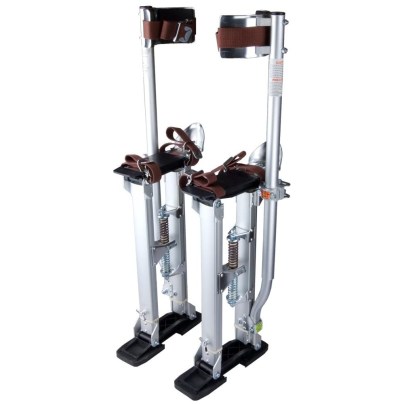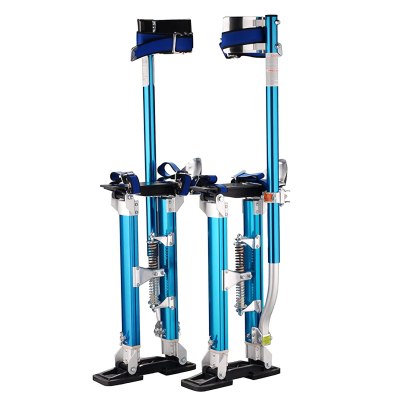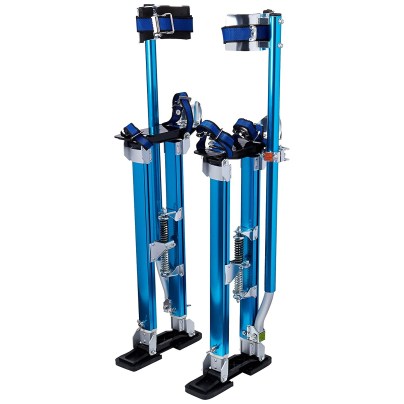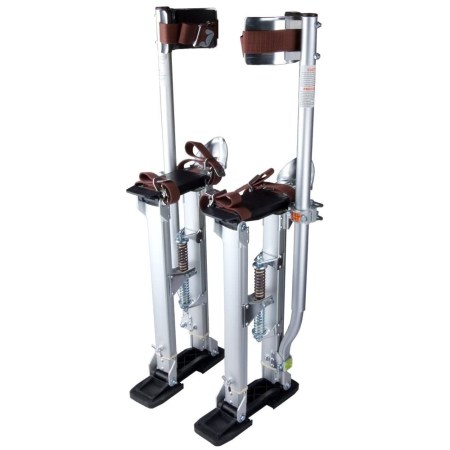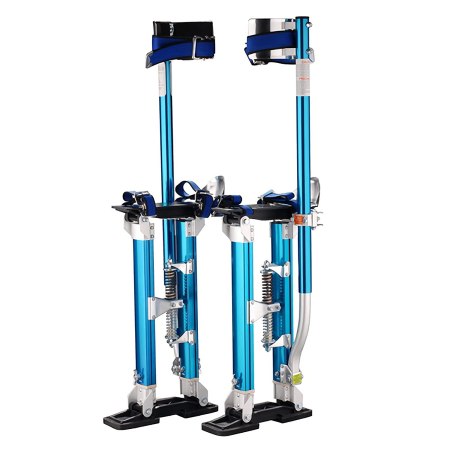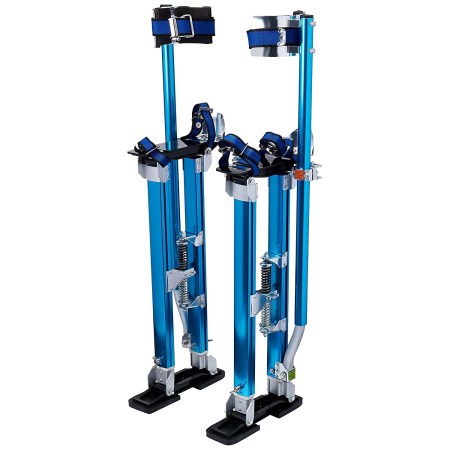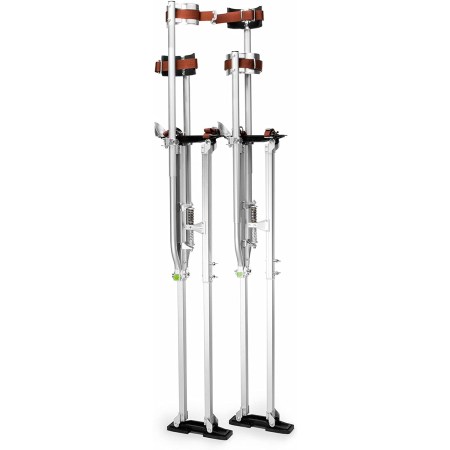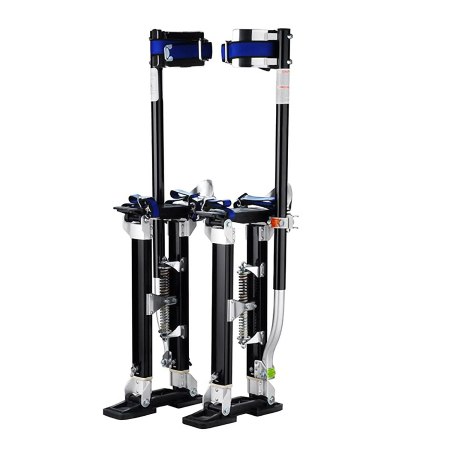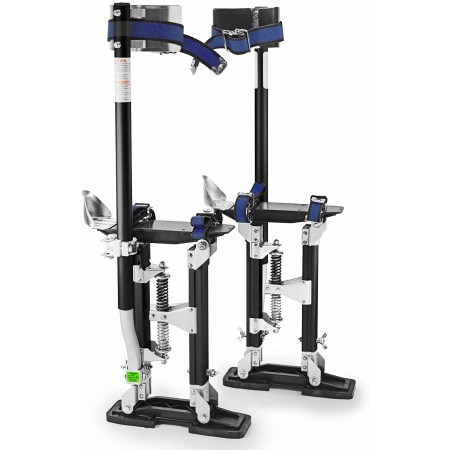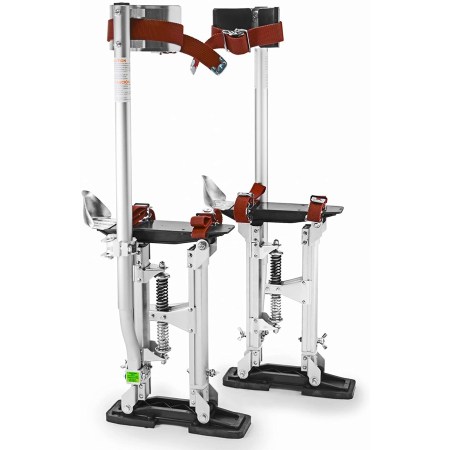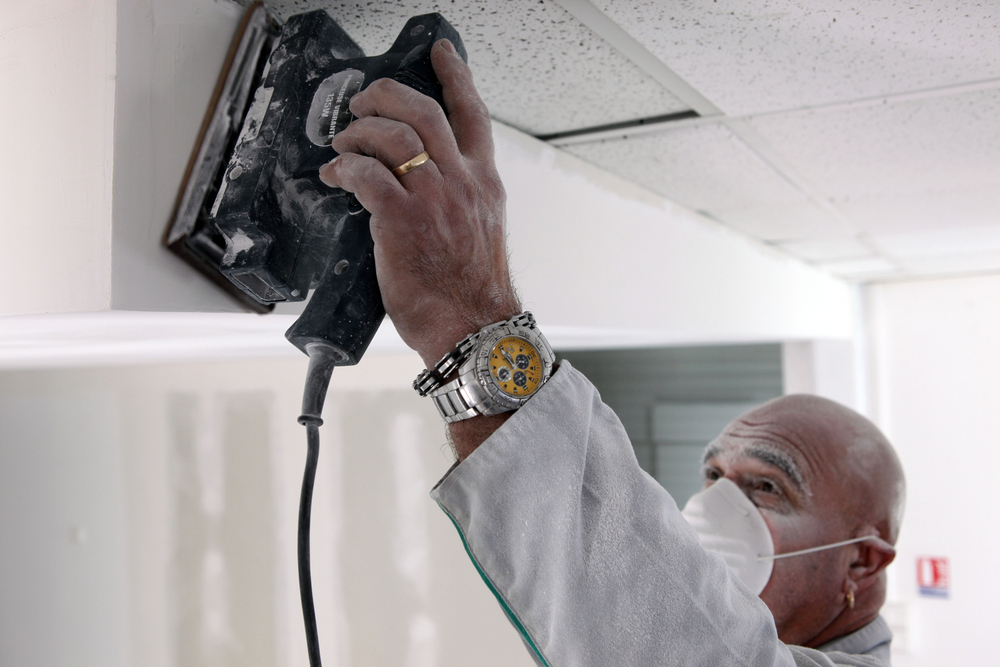
We may earn revenue from the products available on this page and participate in affiliate programs. Learn More ›
Anytime a DIYer or industry professional needs to work up at heights, the usual tool for this purpose is a ladder. However, ladders remain stationary, and when installing drywall, the user is required to climb down, move the ladder, and climb back up without dropping materials or having individual fasteners tear through the drywall while moving to a different portion to secure it. Instead, when hanging drywall to finish a room or putting up a ceiling, the mobility of drywall stilts can make the job much easier.
The best drywall stilts need to be tall enough for the user to comfortably work without stretching or becoming off-balance. Keep in mind that stilts should have safety features like nonslip feet and secure leg straps to help reduce the risk of injury due to slips, trips, or falls. The list of top products below is a great place to start looking for the best drywall stilts for your next project.
- BEST OVERALL: Yescom 24″-40″ Professional Grade Adjustable Drywall
- BEST BANG FOR THE BUCK: 1117 Pentagon Tool “Tall Guyz” Professional 18″-30″
- BEST PROFESSIONAL GRADE: 1121 Pentagon Tool Professional 24″-40″ Blue Drywall
- BEST HEIGHT RANGE: GypTool Pro 48″ – 64″ Drywall Stilts – Silver
- BEST SAFETY FEATURES: 1120 Pentagon Tool “Tall Guyz” Professional 24″-40″
- BEST LIGHTWEIGHT: GypTool Pro 15″ – 23″ Drywall Stilts – Black
- BEST FOR EXPERIENCED USERS: GypTool Pro 24″ – 40″ Drywall Stilts – Silver
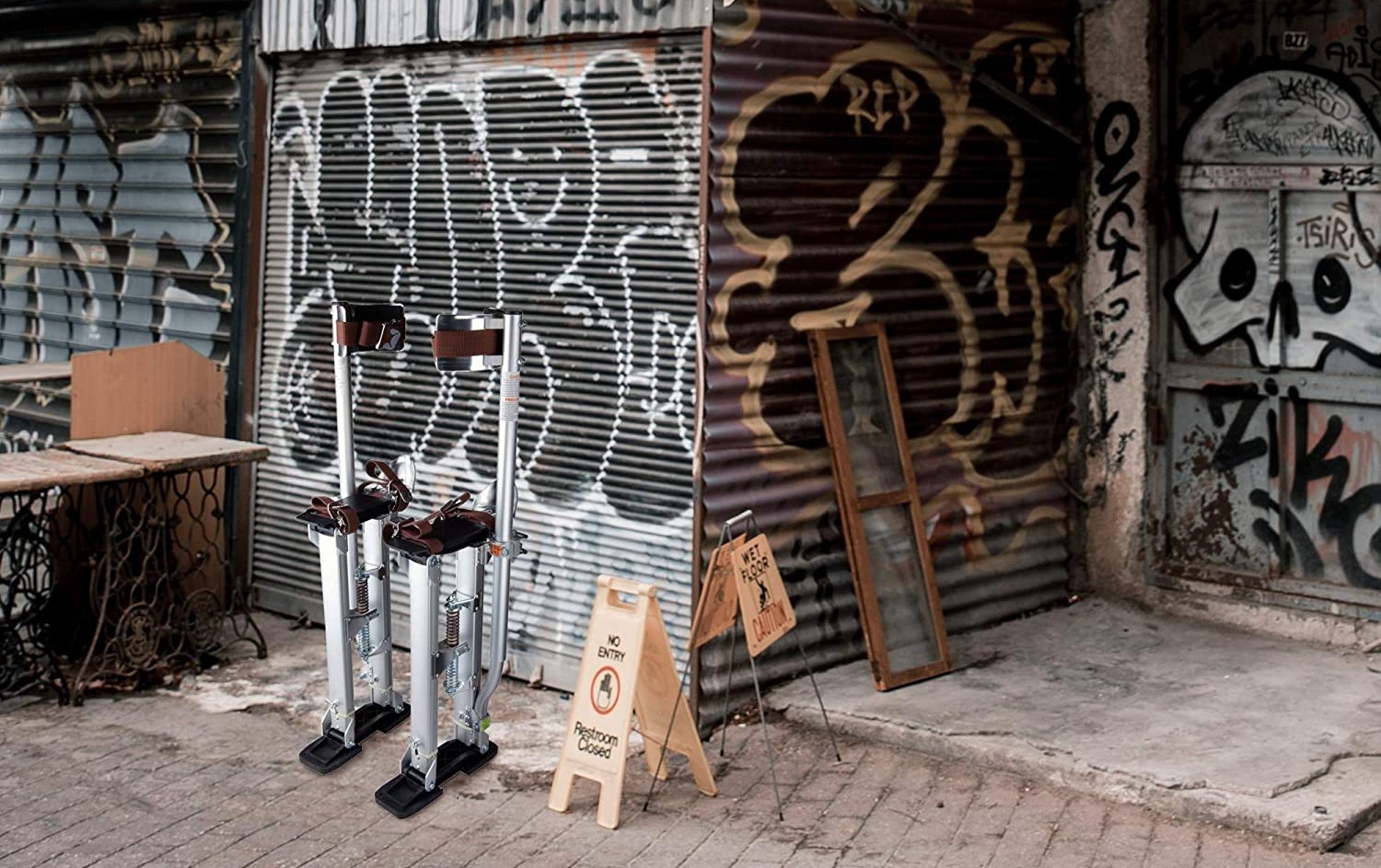
What to Consider When Choosing the Best Drywall Stilts
When shopping for a high-quality set of drywall stilts, it’s important to find a pair that is lightweight and flexible but durable enough to withstand the weight, movement, and momentum of the user. Also consider the stilt supports, the weight capacity, and the extension length as well as several other important factors mentioned below.
Material
The material of which drywall stilts are made is a factor that affects the weight, durability, and flexibility of the stilts. Typically, drywall stilts are made of stainless steel, aluminum, or magnesium.
- Stainless steel is a durable metal that is stronger and heavier than either aluminum or magnesium. This means that it can support the weight of heavier users, but the stilts are too heavy to be a good option for long workdays or big projects.
- Aluminum is the most common material used to make drywall stilts because it’s lightweight, affordable, and durable. These stilts are more flexible than stainless steel, absorbing some of the weight and momentum of the user to make them easier and more comfortable to wear while moving or walking.
- Magnesium is a very light material used to make stilts that isn’t as common or as durable as aluminum. However, it is lighter and more flexible, making it a great choice to reduce muscle fatigue over long periods of stilt use.
Support
Stepping onto a pair of stilts sounds daunting until you realize that they aren’t just a set of sticks mounted on a couple of rubber feet. They’re actually considerably more sophisticated, with footplates, foot straps, and leg straps. They may also include calf supports and ratcheting systems for simple, effective tightening.
The calf supports and locking straps effectively secure the stilts to the entire length of the user’s calf, allowing them to lift and move the stilt as if it were a part of their own body. Without the support, the user would be fighting to lift and pull the bottom of the stilt using only their foot and ankle, which could lead to tripping and muscle strain.
Footplate
The footplate is the portion of the stilts where the user places their feet. This is similar to the sole of a shoe, so comfort and support are the most important concerns. A wide footplate gives the user more space to adjust and position their feet, allowing them to find an optimal point of balance instead of rocking back and forth to try to maintain an unsteady momentum while working.
Look for drywall stilts that feature adjustable heel brackets so that the size and shape of the footplate can be customized to fit the specific user. Most stilts will accommodate average foot sizes, but foot straps can help secure the fit of the stilts so that the user is more stable.
Comfort
Whenever a new accessory, bag, or tool is being strapped to a person, comfort should be an important consideration that ties in closely with safety. Padded straps can help prevent chafing on the legs and feet, though it may be a good idea to wear jeans or work pants with the stilts so that the straps can be tightened without rubbing the skin on the legs.
Flexibility is another consideration that can make stilts more comfortable. This is because when the user takes a step, they are moving their entire body weight up and placing it back down onto a solid piece of metal. The flexible material and a dual-spring mechanism in the stilt struts allow the stilt to absorb some of this weight and momentum, putting less strain on the feet and legs.
Extension-Height Range
The extension-height range of a pair of drywall stilts refers to how short or how tall the stilts can be made. Before deciding on a set of stilts, it’s important to know how high they need to extend.
- Short drywall stilts are great for working inside the average home with extension-height ranges between just 12 and 24 inches. This 1- to 2-foot increase allows beginners to get used to being on stilts without the risk of a much higher fall.
- Standard drywall stilts typically range from 24 to 48 inches. These stilts are ideal for installing ceiling lights, putting in a drop ceiling, or hanging drywall.
- Tall drywall stilts are more common in industrial or commercial settings because they can add between 48 and 72 inches in height. Even at the lowest setting, this is too high to be useful inside most homes, though they can be used to work on the gutters or put up decorations like Christmas lights.
Weight Capacity
The weight restriction on drywall stilts might initially be confusing. If a set of stilts advertises a load-bearing capacity of 230 pounds, this can lead some people to believe that the stilts can collectively support more than 400 pounds. However, drywall stilts are made so that each stilt can independently support the entire weight of the user because when one foot gets picked up, all of the user’s weight is placed on the remaining stilt.
- Stainless steel stilts are the best option for heavy users because they are stronger and more durable than either aluminum or magnesium. However, they are also heavier, so if you don’t need the extra weight capacity, it isn’t advised to use these stilts.
- Aluminum stilts often have a weight capacity of between 220 and 240 pounds, which is ideal for most users. The lightweight yet durable material is ideal for big projects and professionals who may use the stilts daily.
- Magnesium stilts are a good choice for lightweight users, with weight restrictions from 200 to 230 pounds and falling just below the capacity of aluminum stilts. They also have the benefit of weighing less than aluminum, so less effort is needed to walk and move around.
Safety
The safety of users needs to be a primary consideration when selecting and using drywall stilts. According to the CDC, thousands of individuals risk severe injuries from falls in workplaces across the country every year. While a few feet may not seem like a big concern, a slip or awkward landing could cause fractures, torn muscles, strained ligaments, swollen joints, and bruising. It’s also a good idea to take regular breaks to avoid muscle cramps.
Due to the risk posed by simple slips, trips, and falls, a set of drywall stilts should have wide, nonslip rubber feet with textured soles that can grip the floor for better balance and stability. Customizable adjustments to the footplate, heel bracket, and foot straps provide a more secure fit, and calf supports make it easier to move the stilt so that it doesn’t drag or catch on a transition lip, carpet, or any other object.
Our Top Picks
The following products are some of the best drywall stilts on the market in terms of quality, features, and value. The important shopping tips and considerations noted above will help determine which of these top products would be the best option for your next drywall project.
Best Overall
Yescom 24u0022-40u0022 Professional Grade Adjustable Drywall
The Yescom Professional Grade Adjustable Drywall Stilts are made with durable lightweight aluminum alloy that will resist bending or warping even after extensive use. The drywall stilts have a base height of 24 inches and can be extended up to 40 inches to accommodate different working and user heights. The stilt feet are made with a skid-resistant rubber that helps prevent slippage while the stilts are in use.
These stilts weigh just 15.4 pounds, but they can support a user weight of up to 227 pounds. They also have adjustable leg straps and heel brackets on the footplates to ensure that the stilts can provide a secure fit to a variety of users. The dual-action springs in the stilts allow them to absorb and flex with each step for a more natural feeling that makes it easier to balance.
Best Bang For The Buck
1117 Pentagon Tool u0022Tall Guyzu0022 Professional 18u0022-30u0022
The lightweight construction of these aluminum drywall stilts with a combined weight of just 15.5 pounds is great for reducing leg fatigue through long workdays. These affordable stilts are an excellent addition to a variety of projects, including drywall, painting, wiring, or installing drop ceilings, with a minimum height setting of 18 inches and a maximum height of 30 inches.
No tools are needed to adjust the height of the stilts. Just remove the wing nuts and bolts from the extension tube, change the height of the tube. and replace the wing nuts and bolts. The drywall stilts have a maximum weight capacity of 228 pounds, and they have adjustable heel brackets and foot straps, allowing them to be worn properly and securely by different users. The nonslip rubber feet and short minimum height make these stilts a good option for beginners.
Best Professional Grade
1121 Pentagon Tool Professional 24u0022-40u0022 Blue Drywall
These high-quality drywall stilts are excellent for professionals working on electrical systems; installing ceiling lights; and hanging, taping, and painting drywall. The wide footplates have adjustable heel brackets for a range of users as well as foot straps to help keep the stilts securely attached. These aluminum drywall stilts weigh 17.5 pounds, so they won’t cause a lot of leg fatigue, though users should take regular breaks to avoid muscle cramps.
The weight capacity of the stilts is 228 pounds, and they are adjustable in height from a minimum of 24 inches to a maximum height of 40 inches. The height setting is adjusted by removing a locking wing nut and bolt, allowing the stilts to be adjusted without tools. The nonslip rubber feet help prevent slipping, and the dual-spring action in the stilt legs makes it easier to walk and balance by absorbing energy with every movement.
Best Height Range
GypTool Pro 48u0022 – 64u0022 Drywall Stilts – Silver
The height range of these stable stilts stretches from 48 inches to 64 inches, making it easy to paint ceilings, clean gutters, and clean windows. The sturdy aluminum frame has excellent flexibility and includes a dual-spring system for additional impact absorption, making it easier for the user to take steps and move around without losing their balance.
The height of the stilts can be adjusted without tools by simply moving a pair of wing nuts and bolts in the extension tubes. The stilts weigh 27.7 pounds and have a maximum weight capacity of 227 pounds with extra-wide padded calf braces for additional support. High-grade rubber feet on the stilts are nonslip and nonmarring so they won’t scratch or otherwise damage the floors.
Best Safety Features
1120 Pentagon Tool u0022Tall Guyzu0022 Professional 24u0022-40u0022
This pair of drywall stilts prioritizes safety with self-locking buckles that only need to be set once before they can quickly and easily be secured with every use. The stilts also have premium-grade rubber feet with textured grips to help prevent slips or trips. Adjust the heel brackets and foot straps for a customized fit so that the stilts aren’t too tight or too loose, which could result in a dangerous fall.
For beginners, the height can be set to a minimum of 24 inches so that any falls are only from a couple of feet above the ground. The maximum height setting is 40 inches, and the aluminum stilts can support up to 228 pounds despite weighing just 17.5 pounds combined. Dual-spring flexibility in the stilts makes them more comfortable to use because they absorb a portion of the energy transferred down through the leg and into the stilt with each step.
Best Lightweight
GypTool Pro 15u0022 – 23u0022 Drywall Stilts – Black
Big drywall project? Consider these GypTool drywall stilts, which are built with durable aluminum strut tubing that makes these stilts lightweight and flexible. Together, the stilts weigh just 13.8 pounds, meaning each leg lifts only about 7 pounds with each step. The aluminum tubing can support up to 225 pounds while allowing the stilts to flex and absorb the user’s weight and momentum with a dual-spring system
Set the height easily on these drywall stilts without using any tools. They have a simple wing nut design that secures the extension tubes in place with a minimum height of 15 inches and a maximum height of 23 inches. This short height range and the nonslip rubber feet are ideal for beginners who may not be confident on taller stilts.
Best For Experienced Users
GypTool Pro 24u0022 – 40u0022 Drywall Stilts – Silver
Each drywall stilt weighs about 8.5 pounds, for a combined weight of 17 pounds, and is made with high-grade aluminum that’s resistant to heat, water, and corrosion. These stilts are a great choice for professionals in the carpentry, electrical, and plumbing trades as well as for experienced DIYers who need to install ceiling lighting, put up drywall, or paint the walls or ceilings.
Adjustable from 24 inches to 40 inches in height, these stilts have a maximum weight restriction of 225 pounds. The heel brackets can be adjusted on the footplate of each stilt to better accommodate various foot sizes. The leg straps can also be adjusted for a secure fit with wide, padded calf braces and auto-locking buckles that need to be set to the proper fit only once.
Tips for Using Drywall Stilts
The freedom and mobility of drywall stilts can’t be denied, but there are a few things to keep in mind in order to work safely and minimize the risk of injury. The user should always clear the work area, ensuring that items like work bags, rugs, and tables are completely removed to help prevent trips and falls while fastening or taping drywall.
Working at heights isn’t a familiar feeling for most people, and it can be easy to forget that there are a variety of obstacles that can be hazardous. Things like ceiling lights or door jambs that go mostly unnoticed at ground level can cause head injuries if the user isn’t careful.
To help ensure the safety of the user, beginners should always start with the stilts at the lowest height level. While this won’t prevent the user from falling, it would result in a shorter fall so there is less risk of injury.
- Before the drywall stilts are secured to the user’s legs, the room should be cleared of any items that could pose a tripping hazard.
- Keep in mind that obstacles like door jambs and ceiling lights will be at head level.
- Beginners should practice at the lowest height setting until they become proficient.
FAQs About Drywall Stilts
Consider these frequently asked questions about drywall stilts if you aren’t certain about what product would be suitable for your next drywall project or if you are concerned about the safety of drywall stilts.
Q. Are drywall stilts dangerous?
Drywall stilts attempt to make work faster and easier by providing a very mobile alternative to a ladder or scaffold. However, stilts place the user in danger of falling and should be used with a high degree of precaution to prevent slipping, tripping, and falling. They can also cause head injuries if the user isn’t paying attention and hits their head on a ceiling, light, doorframe, or any other obstruction.
Q. Are drywall stilts hard to use?
Drywall stilts can look intimidating at first, but the wide rubber base and leg supports help ensure that it only takes a few projects before the average user can become proficient with stilts. However, if you will only need them once or twice, it may be better to use a ladder because they do take some time to learn how to use.
Q. How tall should stilts be?
Within a height range of 15 inches to over 5 feet (60 inches), stilts should be high enough to allow the user to comfortably reach the area where they will be working without stretching or becoming off-balance.
Q. Are stilts OSHA approved?
Drywall stilts are OSHA approved in most places. However, before choosing a set, it’s a good idea to look up local OSHA regulations to be certain that they are permitted where you live.
Q. How do you adjust drywall stilts?
Drywall stilts can be adjusted by removing a bolt in the extension tubes and raising or lowering the tube until it is aligned with a new hole. Then just replace and secure the bolt in the new position, and the stilts will then stand at a different height.
